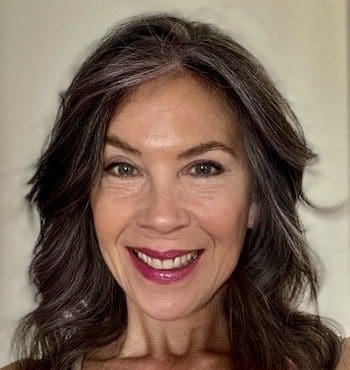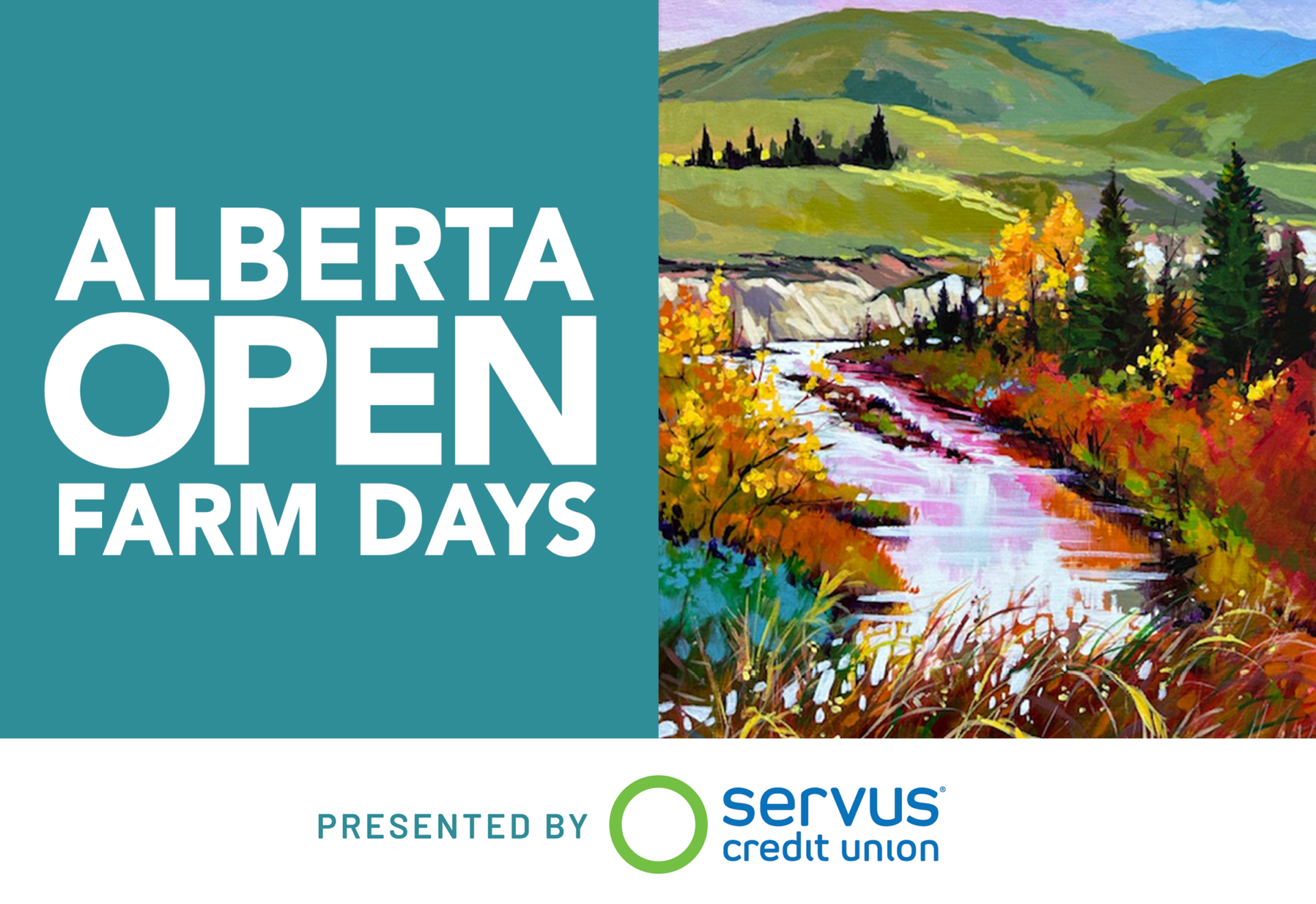
This year, Open Farm Days is excited to announce our partnership with artist Liz Buller Page to celebrate our agricultural theme this year, Bison. You’ll be able to see Liz’s image of a buffalo incorporating native plants within the body of this female buffalo including wild flowers, grasses, and berries.

About Liz
 Liz is a member of the Treaty 6 Mistawasis Nehiyawak of Saskatchewan, and lives in Calgary, Alberta. Liz creates art cards, prints, jewelry and handicrafts and her goal is to share the beautiful art and culture of the Plains Cree. Learning the Cree language and traditional way of life began during childhood visits to her grandparents, Rosina Demarais Campbell, and James Solomon Buller in North Batteford, Saskatchewan.
Liz is a member of the Treaty 6 Mistawasis Nehiyawak of Saskatchewan, and lives in Calgary, Alberta. Liz creates art cards, prints, jewelry and handicrafts and her goal is to share the beautiful art and culture of the Plains Cree. Learning the Cree language and traditional way of life began during childhood visits to her grandparents, Rosina Demarais Campbell, and James Solomon Buller in North Batteford, Saskatchewan.
Her first art card drawing is based on the floral beadwork design on a moose hide pipe bag she was gifted from her Kokum (grandmother). Liz was born in Montreal, and has lived in Ottawa, Calgary, Banff, Red Deer, Saskatoon, and Victoria. In her mid 30’s, Liz was diagnosed with Lupus and had to change her way of working, and find new paths forward. Focusing on drawing, craft making, and further studies of Cree culture, she took courses in jewelry making techniques and design.
Over the years Liz developed her artistic expression. Her sister Suzanne Page is a ceramic artist and teacher and has been at the heart of Liz’s creative development. The sisters continue to enjoy working together on many projects. Liz is involved in community volunteering, supporting local mental health programs, and the Lupus Society. In 2022, Liz’s drawings were included in the Aboriginal Friendship Centres of Saskatchewan project “REIGNITING SACRED FIRES” colouring book.
Liz Buller Page is a member of the Awo Taan Healing Lodge in Calgary and enjoys visiting family, friends, listening to music, and reading. She loves walking in the prairies, coulees, foothills, mountains, and woodlands. In nature she finds the goodness in life.
Liz remembers an old Cree saying from her Moshum (grandfather),
“Don’t forget to show the Creator you are happy to be here.”
Interview with Liz Buller Page
We interviewed Liz about her art and her connection with bison, and the significance of the bison as a food source.
Message from Liz
Firstly, I wish to acknowledge that we live in Treaty 7 Territory here in Calgary, and that throughout Alberta, there are four other First Nation Territories, and the Metis Settlements. I am a member of the Treaty 6, Mistawasis *Nehiyawak of Saskatchewan.
I am not an expert on First Nations subjects. I grew up living in cities, away from the traditional Cree ways. My study of Cree (*Nehiyawak) culture and language is a life long journey, and a labour of love for my ancestors. My grandfather’s first language was Cree, and he taught us basic lessons during summer visits. The importance of the Buffalo was learned at a young age.
Traditionally, Cree and other First Nations stories are passed from generation to generation through storytelling. We find the Buffalo in our art, dances, stories and spiritual practices…..which have not always
been accurately recorded or understood by western scholars.
Open Farm Days: Liz, in your art the direct translation of the Cree (Nehiyawak) word is Buffalo, can you explain the difference between buffalo and bison and it’s significance?
Liz: Although the scientific name is bison, buffalo is the word used by myself and most people of First Nations ancestry. I have personally only heard the word “Buffalo” used by First Nations people. I checked the language dictionaries for Cree, Blackfoot, Dene; and the English translations are consistently Buffalo. Perhaps the reason for this is that early French trappers used the term “boeuf” to describe the North American Bison, so, the first European translation would have been derived from “boeuf”, which became the word “buffalo.” I am accustomed to using the word buffalo instead of bison to describe this sacred
animal. Searching cultural sites in Alberta, I again find the word buffalo – Buffalo Nations at Luxton Museum, Head Smashed In Buffalo Jump, and Wood Buffalo Park.
OFD: Can you tell us about your design and the symbolism.
Liz: I drew native plants within the body of this female buffalo….wild flowers, grasses, and berries. This illustrates the natural “cycle of life”. The earth feeds the buffalo, and in turn, the buffalo sustains and feeds the earth and her inhabitants. In the centre of this buffalo is the wild rose, an important First Nations image of vitality and survival. The wild rose is also used in teas
and medicines. The red line or arrow which leads from the buffalo’s mouth to the wild rose is a traditional First Nations image of the “life force“ within all animals.
My buffalo image is turquoise blue in loving memory of my mother. Turquoise was her favourite colour. This buffalo is female to honour the nurturing, loving, teaching, and support we receive from our mothers, sisters, other female relatives, and friends.
OFD: You have a really rich background with food and agriculture as well!
Liz: I was fortunate to spend many childhood summers on the grain farm of close family friends. I remember harvest time, everyone helped out in some way. Seeing fields of ripe flax, mustard, barley, wheat, canola was a glorious sight. I remember the wonder I felt the first time I dug a potato from garden soil, and went berry picking. Other fond memories; learning how to prepare Sunday dinner, and setting the table for family meals.
For many years, I worked in restaurants and hotels. I witnessed the behind the scenes teamwork, experience, and resources it takes to bring food to our tables. The hospitality and agriculture industry are an important part of the economy, as well as a place to showcase the many beautiful places, and wide ranging culinary backgrounds we have in Alberta!
OFD: Given your background not only as an Indigenous artist, but also from your culinary background, what for you, is the significance of the buffalo as a food source in 2023?
Liz: For the First Nations People, the Buffalo is sacred. Traditionally, all of the Buffalo was used, nothing was wasted. Buffalo provided everything needed for survival….food, tools, housing, clothing, fuel. Prayers of thanks were always given to the Buffalo during and after the hunts.
Today, it is still important to not be wasteful. Nothing in this world is limitless. We should remember that everything produced by farmers and ranchers is a result of a lot of hard work, and long days. Concerns about weather, and other forces beyond anyone’s control are constant. I believe that having an understanding of where our food comes from helps us connect with the Earth, and each other. There are lessons to be learned about the relationship between the First Nations People and the Buffalo…. and how we manage and respect our resources and sources of food, now, and in the future. Any opportunity to visit and learn about where our food comes from is well worth the time it takes. As a Cree person, I personally am thankful that the Buffalo is the featured animal for Open Farm Days this year. We should all be grateful that we still have this magnificent animal living among us today.
Footnote
*NEHIYAWAK is the word the First Nations Cree use to call themselves. NEHIYAWAK means “The Exact People”. CREE is a word invented by the early European traders and missionaries, it is an abbreviated term for the word Kristinos, “people believing in Christ”. You will see the word Nehiyawak used more often in the future.

